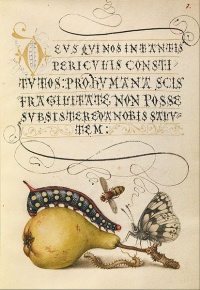Insect
From The Art and Popular Culture Encyclopedia
|
"Fifty million years before the first bird would appear the insects had accomplished flight."--The Hellstrom Chronicle (1971) "When he is dominated by sexual desire, he will believe everything you happen to tell him. Knock on a stone with your fingernail - in his own morse code - and at once he answers."--The Soul of the White Ant (1925) by Eugène Marais |

|
Related e |
|
Featured: |
Insects are a class of living creatures within the arthropods that have a chitinous exoskeleton, a three-part body (head, thorax, and abdomen), three pairs of jointed legs, compound eyes, and two antennae. They are among the most diverse groups of animals on the planet, including more than a million described species and represent more than half of all known living organisms.
Contents |
In culture
Scarab beetles held religious and cultural symbolism in Old Egypt, Greece and some shamanistic Old World cultures. The ancient Chinese regarded cicadas as symbols of rebirth or immortality. In Mesopotamian literature, the epic poem of Gilgamesh has allusions to Odonata which signify the impossibility of immortality.
Amongst the Aborigines of Australia of the Arrernte language groups, honey ants and witchety grubs served as personal clan totems. In the case of the 'San' bush-men of the Kalahari, it is the praying mantis which holds much cultural significance including creation and zen-like patience in waiting.
In fiction
- The Metamorphosis by Kafka
In art
Insects have found uses in art, as in other aspects of culture, both symbolically and physically, from ancient times. Artforms include the direct usage of beetlewing (elytra) in paintings, textiles, and jewellery, as well as the representation of insects in fine arts such as paintings and sculpture. Insects have sometimes formed characteristic features of artforms, as in Art Nouveau jewellery.
Insect groups represented in art include bees, beetles, butterflies, grasshoppers, and dragonflies.
See also
- Entomology
- Ethnoentomology
- Flying and gliding animals
- Prehistoric insects
- Ecological importance of bees
- Insect ecology
- Chemical ecology
- Insect biodiversity
- Defense in insects
- List of largest insects

